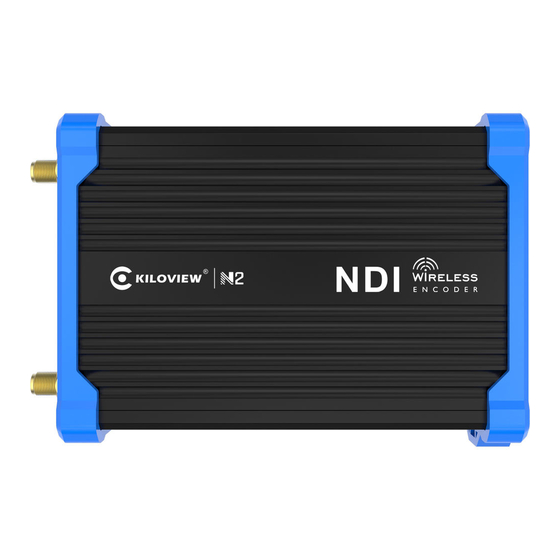
Summarization of Contents
1 Product Introduction
1.1 Key Features and Advantages
Highlights portability, stability, NDI compatibility, and powerful encoding capabilities for video production.
1.2 Technical Specifications
Lists detailed parameters including model, input, protocols, resolution, encoding, and latency.
2 Operation Guidance
Device Installation and Connection
Guides on connecting power and video sources, and powering on the device for initial setup.
Network Connectivity and Configuration
Explains how to connect the encoder to a network via wired or WiFi for management and streaming.
NDI Stream Pulling
Describes how NDI devices automatically discover and pull video streams from the encoder.
Other Streaming Services
Covers NDI stream pulling and configuring other streaming services like RTMP, UDP, HLS.
3 Packing List and Interface Description
3.1 Packing List
Lists all the items provided in the product package for setup and use.
3.2 Interface Description
Identifies and explains the function of each physical connector and status indicator on the encoder.
3.3 Signal Indicators
Signal Status Indicators
Details the meaning of various LED lights on the encoder, indicating device status and connectivity.
4 Installation and Connection
4.1 Power Connection
Instructions for connecting the power adapter, utilizing the built-in battery, and connecting video sources.
4.2 Video Signal Connection
Guides on connecting SDI or HDMI video sources to the encoder's input ports.
4.3 Network Connection
Guides on establishing a network connection using the USB to RJ45 adapter for Ethernet connectivity.
5 Login and Network Configuration
5.1 Login via Ethernet
Step-by-step guide to connect via Ethernet, obtain IP, and access the web management interface.
5.2 Login via WiFi Hotspot
Instructions for connecting to the device's WiFi hotspot to access its web interface for management.
5.3 Network Configuration
Describes the encoder's support for both Ethernet and WiFi network configurations.
5.3.1 Ethernet Configuration
Explains how to configure IP addresses for the Ethernet connection using DHCP or manual settings.
5.3.2 WiFi Network Setup
Details how to connect to existing WiFi networks or configure the device as a WiFi hotspot.
5.3.3 Convenient Management Functions
Covers the "Local Link" feature for dedicated IP access and mobile device connectivity.
6 NDI Discovery and Configuration
6.1 NDI|HX Driver Installation
Instructions for downloading and installing the necessary NDI|HX drivers for Windows and Mac systems.
6.2 NDI Discovery and Connection
Explains how NDI devices are automatically discovered on the network and how to connect using compatible software.
6.3 Modify NDI Device Name and Channel Name
Guides on changing NDI device and channel names for unique identification in a network environment.
6.4 Modifying NDI Bit Rate
Details how to modify the bit rate for the NDI stream for optimal quality and bandwidth usage.
7 Parameters Configuration
7.1 Dashboard
Provides an overview of the device's operational status, system information, and network reachability testing.
7.2 Basic Settings
Indicates where users can access fundamental configuration options for the device.
7.3 Change WEB Login Password
Instructions on how to change the default password for accessing the web management interface.
7.3.1 Location and Time
Details how to configure the device's location and synchronize its time, including NTP settings.
7.3.2 Restore Factory Settings
Explains the methods for restoring the encoder to its original factory default settings.
7.3.3 Firmware Upgrading
Guides users through the steps for updating the device's firmware online.
7.4 Video & Audio Adjustments
7.4.1 Video Source Choice and Adjustments
Covers selecting video input sources and adjusting visual parameters like brightness, contrast, and saturation.
7.4.2 Video Preprocessing
Describes preprocessing steps such as cropping, scaling, and rotation to optimize video before encoding.
7.4.3 Audio Signal Source
Explains how to choose the audio source and mentions automatic selection for embedded audio.
7.5 Encoding & Stream
7.5.1 Audio Encoding Parameter Setting
Details how to configure audio encoding parameters, including mode, sampling rate, channels, and bitrate.
7.5.2 Encoding and Stream Settings
Guides on setting up the primary video stream encoding parameters for H.264 output.
7.5.3 Streaming Media Service
Lists and explains the available streaming protocols such as NDI, RTMP, HLS, and TS-UDP.
7.6 Local Recording
Recording Operation
Instructions on how to start, stop, and manage local video recordings using TF cards or USB storage.
7.7 Network Storage (NAS)
Add NAS Configuration
Provides steps for adding and configuring network-attached storage (NAS) for file storage and retrieval.
7.8 Text/Image/Time Overlay
7.8.1 Overlay Image Management
Details the process of uploading, managing, and preparing images for overlay on the video stream.
7.8.2 Overlay Function
Explains how to enable and customize text, time, and image overlays on the video output.
7.9 Service Configuration
7.9.1 Web Service Configuration
Guides on changing the default web service ports (HTTP/HTTPS) for accessing the device's interface.
7.9.2 Onvif Service Configuration
Notes that ONVIF discovery is not currently supported for N series devices.
7.9.3 Telnet Service Configuration
Instructions on enabling or disabling the Telnet service for remote debugging and troubleshooting.
7.10 Serial Ports and PTZ
7.10.1 Serial Ports
Details setting up serial communication parameters for connected devices via USB to serial adapters.
7.10.2 PTZ Setting
Explains how to configure PTZ camera control protocols and movement speeds.
7.10.3 Control Panel
Describes the on-screen controls for remotely operating PTZ camera functions like movement and zoom.
7.11 Quick Reset and Reboot
7.11.1 Quick Reset
Used to quickly reset video encoding services after modifications or abnormal operation.
7.11.2 Reboot
Used to restart the device software, taking approximately 3 minutes to complete.

















Need help?
Do you have a question about the N2 and is the answer not in the manual?
Questions and answers